Art
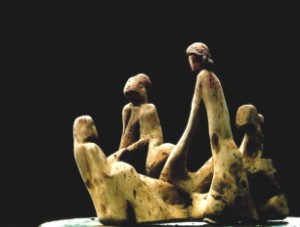 Everyday Everyday
Aesthetics
Mustafa
Zaman
It
was in 1990, when SM Sultan visited the home of the artist
Priyobhashini and ecstatically declared, "You are a true
artist" that Priyabhashini woke up to her own talent.
Before that deciding moment she never thought much of her
own sculptural creations, she didn't even considere them to
be art works. She made them as she felt a compulsion to do
so. However, she took immense pleasure as a root of tree,
a trunk or a part of it gradually took a different shape in
her hands.
Driftwood,
roots and trunks constitute her vehicle. She courses these
articles -- her base metal -- through process of transmutation.
As they change and start to take recognisable shapes of humans
or birds, she stops at a point with the mutation remaining
incomplete. Her art banks on the vaguenesses that the incompleteness
of the transformation that she, as an artist, initiates.
However,
as sculptures they are complete. The vision, with which she
is able to determine the fate of the raw material she deals
with, brings into view the essence of a human or two, or a
bird in its contemplative solitude.
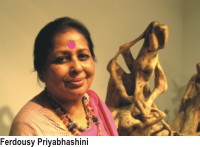 With
birds she remains a calm observer, rarely showing one in flight
or in any other posture but stillness, with humans she sheds
her reservation, and presents them in gaits of ecstatic turmoil,
not of psychological nature, but of a physical one. Priyobashini's
intertwined roots of trees turned into human couples are sights
of joy. She is unreserved in her depiction of the vortex of
sensation her couples find themselves into. The material she
works with plays a role. While working with a root that looks
like a cluster of muscles in motion, her desired end is always
swirling and gesticulating humans. With
birds she remains a calm observer, rarely showing one in flight
or in any other posture but stillness, with humans she sheds
her reservation, and presents them in gaits of ecstatic turmoil,
not of psychological nature, but of a physical one. Priyobashini's
intertwined roots of trees turned into human couples are sights
of joy. She is unreserved in her depiction of the vortex of
sensation her couples find themselves into. The material she
works with plays a role. While working with a root that looks
like a cluster of muscles in motion, her desired end is always
swirling and gesticulating humans.
She
has been doing it for more than fifteen years. The visual
ecstasy that she harps on has struck a different chord in
many a mind. However, the recent solo show at Bengal Gallery
of Fine Arts, showcases her already familiar art form and
more. She displays her own brand of horticulture.
"I
used to throw away a good portion of the tree trunks after
I have finished my sculptures.
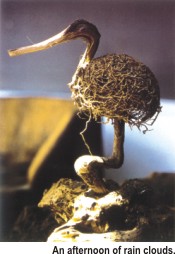 And
suddenly one day I thought, why not use them as handmade pots
for my plants," she confides. This process of turning
tree trunks or even roots into a plant-pot has started a whole
new cycle in her life. The results are displayed in the gallery,
but these experiments in plantation took years to master. And
suddenly one day I thought, why not use them as handmade pots
for my plants," she confides. This process of turning
tree trunks or even roots into a plant-pot has started a whole
new cycle in her life. The results are displayed in the gallery,
but these experiments in plantation took years to master.
"The
Pakur tree that you see in the gallery, has been with me for
last fourteen years," says the artist. She makes it a
point to treat these trees as part of her family. She is always
on the look out for a roadside sapling or a small tree that
soon will be uprooted by anyone next to us.
Both
with the material for her sculpture and plant, Priyobhashini
remains an artist dependent on indigenous resources. Hers
certainly is an independent and alternative way. "Even
if I go somewhere to attend a seminar and I stumble into a
sapling or a tree trunk, I pick it up and take it home,"
she reveals how she accumulates her raw material. At one time
she couldn't help nullify her husband's request to keep her
hands off a tree that she desired to save.
It
was during a funeral and she was as usual adamant to get her
tree to replant it in one her pots. To make things look civilised,
she went back in the evening to pick up her tree.
Though
a certain sense of beauty governs Priyabhashini's world, she
makes it a point that things don't get bogged down in the
desire to decorate the house. Although her plants are meant
for urbanites who lack proper space for planting trees, she
says, "It is more about bringing a patch of green in
your own home than about decorating the home. It is mostly
about saving the trees."
In
her effort to keep this process going, she has made many an
attempt to rescue roadside saplings. She, in this respect,
is true to her word. Her total presentation comprises only
of the indigenous variety that we often ignore, as they do
not easily appeal to the urban sets of eyes.
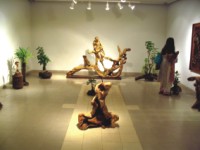 Apart
from the huge sculptural pieces or plants, there are simple
craft-like presentations. The best example of this is the
Pakur tree and the way it was adorned with encircling boats.
The tree itself is of human-height and she turns it into an
occasion to create a virtual miniature ghat -- a river station
where boats are anchored under such trees. To make her small
boats, Priyabhashini uses the outer coverings of the pod from
which the coconuts emerge at the early stage of flowering.
Their beauty is in their simplicity. She is crafty, but never
too much to make her works look like products. Apart
from the huge sculptural pieces or plants, there are simple
craft-like presentations. The best example of this is the
Pakur tree and the way it was adorned with encircling boats.
The tree itself is of human-height and she turns it into an
occasion to create a virtual miniature ghat -- a river station
where boats are anchored under such trees. To make her small
boats, Priyabhashini uses the outer coverings of the pod from
which the coconuts emerge at the early stage of flowering.
Their beauty is in their simplicity. She is crafty, but never
too much to make her works look like products.
What
is it that makes her work so fraught with emotion? It is the
seemingly pristine look and the feel of the natural. The manipulation
is so subtle that her work gives the impression as if they
each were formed through a long natural process. The patina
of the old and weathered wood also adds to the aura that she
strives to create. Usually she sticks to colours that hide
any sign of sanding. And polishing is avoided altogether.
Yet in this show a couple of new works veer to a different
look -- they are sand to show the true colour of the wood,
which is yellow-white. The work titled "Emon diney tarey
bola jaey" (In such a day you could tell one) is one
human-like form growing out of another. They are a couple
-- mutating towards an unknown end.
The
same sense of metamorphosis is brought into the work "Shey
rater kotha" (The story of that night). The suggestion
of humans are even fainter in this tangle of roots embracing
one another. The effect of having to confront piece like this
lying on floor, presented without a stand or plinth, is a
surreal one. It seems like a naive or expressionist version
of the celebrated Laocoon sculpture of the Hellenic Greece.
Only the grandeur is dropped to initiate the communication
on a human level.
With
all the twists and turns, with all the crafty handling of
material, Priyabhashini's works retain a simplicity akin to
the age-old tradition of crafts in Bangladesh. Perhaps it
is this traditional pull that manifests in her work and makes
them look humble and communicable.
In
the present show, there is an effort to handle an epic theme
in her large-scale work titled -- "Sea-bound". The
sculpture is a feast for the eyes, but it also stands like
a puzzle to be solved by the onlookers. Here, her ambition
exceeds the human level, and it is at the human level that
she comfortably hovers and delivers her emotive (but mute
in their emotional expression) sculptures.
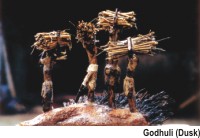 Priyabhashini
displayed a lot of mixed breed plants and creepers. They all
go back to the time when she started working with plants,
which was in 1994. However, in this show the most interesting
species is the fungi that she mounted on the wall. In a number
of painting-like presentations, she composes the tree burke
with soft, white fungi in them. Nigther her tree, nor these
works are presented to create the unreal and sophisticated
look of a Japanese bansi. They thrive in their natural energy
and give the urbanites a chunk of the almost untouched nature
itself. Priyabhashini
displayed a lot of mixed breed plants and creepers. They all
go back to the time when she started working with plants,
which was in 1994. However, in this show the most interesting
species is the fungi that she mounted on the wall. In a number
of painting-like presentations, she composes the tree burke
with soft, white fungi in them. Nigther her tree, nor these
works are presented to create the unreal and sophisticated
look of a Japanese bansi. They thrive in their natural energy
and give the urbanites a chunk of the almost untouched nature
itself.
Though
her target audience is the people who have long ceased to
live in a natural environment, her vision favours the natural
and the rustic in most occasions. Made for people living in
flats, her works strikes a balance between the urban taste
and the rural inheritance. She even dares to negate what the
architectural setting allows for. She says, "I have plans
for designing interiors, where everything geometrical will
be overwhelmed by what is natural. I have plans to plant big
trees on big logs as the pot."
We
only hope that she makes it a reality.
The
exhibition kicked off on July 10 and will last till July 26.
Copyright
(R) thedailystar.net 2004
| 